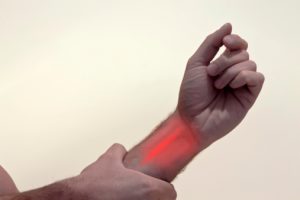
An association has been found between carpal tunnel syndrome and migraine headaches. A study has found that carpal tunnel sufferers are twice more likely to suffer from migraine headaches than those without the condition. Additionally, the association is also seen in migraine headache sufferers having a higher risk of suffering from carpal tunnel syndrome. The findings work as evidence to support the idea that nerve decompression surgery may be an effective means to treat migraine headaches.
For the study researchers analyzed data from close-to 26,000 Americans who responded to a national health survey. Part of the questions asked whether or not a person had carpal tunnel syndrome during the past year and if they had experienced migraine headaches during that time.
Based on definitions, 3.7 percent of respondents had carpal tunnel syndrome and 16.3 percent had migraine headaches. After further analysis researchers found that patients who suffered from migraine headaches had a higher risk of carpal tunnel syndrome and vice versa. Migraine headaches were found in 34 percent of carpal tunnel syndrome patients in comparison to 16 percent without carpal tunnel syndrome. Furthermore, the odds of suffering a migraine headache with carpal tunnel syndrome were 2.6 times higher compared to those without the condition.
Both migraine headaches and carpal tunnel syndrome were found to share similar risk factors including being female, being obese, being diabetic, being of older age and smoking. What was important to note was that Asians had the lowest risk for both conditions and Hispanics had a lower risk of carpal tunnel syndrome.
Previous research has explored the benefits of relieving compressed nerves as a means to relieve migraine headaches but the idea is highly controversial. The new findings help support this notion by revealing the association between carpal tunnel syndrome and migraine headaches.
Migraine headaches commonly affect those of younger age, but can really affect anyone. Carpal tunnel syndrome commonly affects those of older age. Because of this further research will explore if migraine headaches are an early indicator for later-life carpal tunnel syndrome.
What increases risk of carpal tunnel syndrome?
There are certain factors which can increase a person’s risk of developing carpal tunnel syndrome including:
- Being a female – women tend to develop carpal tunnel syndrome more frequently then men
- Being obese
- Menopause
- Kidney failure
- Illnesses which lead to nerve damage like diabetes
- Injury to the wrist like a fracture
- Overuse of a keyboard or mouse
Risk factors and causes of migraine
- Family history
- Age
- Sex
- Hormonal changes
Although there is still much to learn about migraines there are many factors which can contribute to their onset. From hormones to genes to environmental factors these can all cause a migraine.
Common migraine triggers include:
- Hormonal changes
- Certain food like aged cheese or processed food
- Food additives like aspartame
- Beverages like wine and coffee
- Stress
- Sensory stimuli like bright lights
- Changes in wake-sleep pattern
- Physical factors like intense physical exertion
- Changes in the environment
- Certain medications
Symptoms of migraine and carpal tunnel syndrome
The main symptom of migraines is an intense headache which is felt at the front of the head. The headache may feel like a throbbing which may worsen with movement. Sometimes the pain can be felt at the sides of the head and even face and neck.
Other symptoms which may be experiences with migraines include nausea, vomiting, and an increased sensitivity to light and sound.
Symptoms of carpal tunnel syndrome include:
- Numbness in the fingers
- Tingling fingers
- Weakness in the hand
- Burning sensation
- Hands may feel swollen even when swelling isn’t visually seen
Symptoms of carpal tunnel syndrome may occur on their own or in combination with other symptoms. Additionally symptoms may be worsened at night as we bend our wrists in painful positions while we sleep.
Diagnose and treat carpal tunnel syndrome and migraines
- Tinel’s test – tapping on the median nerve to see if the patient experiences numbness or tingling in fingers
- Phalen’s test – pressing hands against each other and having the wrist bent to see if numbness or tingling develops
- Nerve conduction study – electrodes are places on the wrist and a measurement of how long it takes the nerve to transmit impulses is measured
- Electromyography – a fine needle is inserted into the nerve and nerve damage is then measured
- Blood tests
- Imaging scans – x-ray or ultrasound
Treatment of carpal tunnel syndrome consists of the following:
- Resting the hand or wrist
- Using cold compresses
- Controlling triggers like computer use
- Wearing a wrist splint, specifically during the night to keep your wrist immobile
- Corticosteroid injections
- Non-steroidal anti-inflammatory drugs (NSAIDs)
- Surgery
In order to diagnose a migraine there are some common questions to keep in mind.
- What time of the day do the headaches occur?
- What is the location of the headaches?
- What do the headaches feel like?
- How long do the headaches last?
- Have there been changes to behavior or personality?
- Does the position of the headaches change?
- Do you have trouble sleeping?
- Do you have a history of stress?
- Are you experiencing a large amount of stress?
- Is there a history of head trauma?
Additionally your doctor may run the following tests:
- Blood tests
- Sinus x-rays
- Imaging tests like MRI, CT or CAT scan
- Spinal tap
Treatment of migraines involves:
- Medication
- Stress reduction
- Dietary evaluation
- Regular exercise
- Cold packs to the skin
- Pressure applied to the head
- Biofeedback training
- Avoiding triggers – stress, bright lights, etc.
By working with your doctor they can make specific treatment plans for both carpal tunnel syndrome and migraine headaches to offer you the greatest relief.